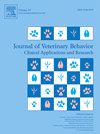常用行为评估方法的障碍-来自一项研究的见解
IF 1.3
3区 农林科学
Q4 BEHAVIORAL SCIENCES
Journal of Veterinary Behavior-clinical Applications and Research
Pub Date : 2025-02-28
DOI:10.1016/j.jveb.2025.02.007
引用次数: 0
摘要
狗的兽医护理可能会被推迟,因为主人担心他们的狗在去兽医医院时会有不好的经历。恐惧和焦虑是狗表现出恐惧和焦虑行为的最常见原因,例如逃避检查或攻击。我们进行了一项安慰剂对照研究,以测试镇静营养品Zylkene®(α-casozepine)对安慰剂的疗效。设计了一项研究,但只招募了少量参与者,因此使用该研究设计进行了初步调查。为了测量恐惧和焦虑,我们开发了一个6分制的定性行为量表,该量表由行为描述符支持。对初步评估的小样本个体的行为进行分析,初步编制本研究的行为量表,并对量表的信度进行检验。采用不同专业水平的四名评价者使用量表,评价者之间的信度为中等至中等,表明需要对量表进行改进。需要更好的定义和描述符,以确保观察者之间的清晰度和可靠性。这些发现支持了现有的研究,即带有行为描述符的定性量表在识别轻度至中度恐惧和焦虑的动物时缺乏可靠性。定性量表没有清晰准确地定义每个情绪得分的行为参数,这可能表明不同的人类评分者在他们的个人假设中是可靠的,但可能不是动物经验的有效指标。我们的研究结果强调了使用定性量表来测量狗的恐惧和焦虑的潜在风险,以及对招募策略进行进一步调查的必要性,以便将更大的样本量纳入动物行为研究。本文章由计算机程序翻译,如有差异,请以英文原文为准。
Obstacles to commonly used behavior assessment methodology – Insights from a research study
Veterinary care for dogs can be delayed due to owner concerns that their dog will have a bad experience when visiting a veterinary hospital. Fear and anxiety are the most common causes for dogs to exhibit fear and anxiety behaviors, such as avoidance of examination or aggression. A placebo-controlled study was developed to test the efficacy of the calming nutraceutical Zylkene® (α-casozepine) against placebo. A study was designed but only small participant numbers were recruited, so a preliminary investigation was carried out using the study design. For measuring fear and anxiety, a 6-point qualitative behavior scale was developed, which was supported by behavioral descriptors. The behaviors of the small sample of individuals from the preliminary assessment were analyzed for the initial development of the study’s behavior scale, and the reliability of the scale was then tested. With four raters of different levels of expertise using the scale, interrater reliability of the scale was fair to moderate, indicating that refinement of the scale was needed. Better definitions and descriptors are required for clarity and therefore reliability between observers. These findings support existing work suggesting that qualitative scales with behavioral descriptors can lack reliability for identifying animals with mild to moderate fear and anxiety. Qualitative scales that do not clearly and precisely define the behavioral parameters for each emotional score could indicate that different human raters are reliable across their individual assumptions but may not be valid indicators of the animal’s experience. Our findings highlighted the potential risks of using qualitative scales for measuring fear and anxiety in dogs, as well as the need for further investigation into recruitment strategies so that larger sample sizes can be enrolled into animal behavior studies.
求助全文
通过发布文献求助,成功后即可免费获取论文全文。
去求助
来源期刊
CiteScore
3.50
自引率
16.70%
发文量
107
审稿时长
325 days
期刊介绍:
Journal of Veterinary Behavior: Clinical Applications and Research is an international journal that focuses on all aspects of veterinary behavioral medicine, with a particular emphasis on clinical applications and research. Articles cover such topics as basic research involving normal signaling or social behaviors, welfare and/or housing issues, molecular or quantitative genetics, and applied behavioral issues (eg, working dogs) that may have implications for clinical interest or assessment.
JVEB is the official journal of the Australian Veterinary Behaviour Interest Group, the British Veterinary Behaviour Association, Gesellschaft fr Tierverhaltensmedizin und Therapie, the International Working Dog Breeding Association, the Pet Professional Guild, the Association Veterinaire Suisse pour la Medecine Comportementale, and The American Veterinary Society of Animal Behavior.

 求助内容:
求助内容: 应助结果提醒方式:
应助结果提醒方式:


